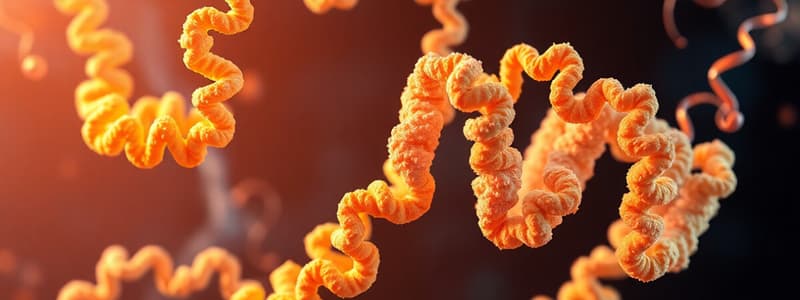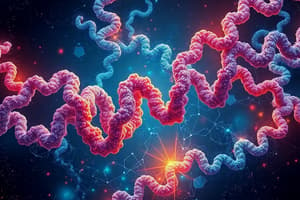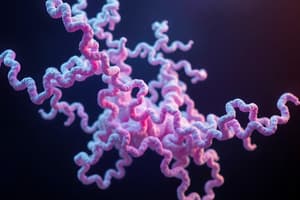Podcast
Questions and Answers
AlphaFold2's primary capability lies in its ability to:
AlphaFold2's primary capability lies in its ability to:
- Identify novel antibiotics.
- Synthesize new proteins with custom functions.
- Predict the structure of virtually all known proteins. (correct)
- Decompose plastic materials effectively.
In the context of microorganism 'learning,' what is the most likely outcome for a genetic mutation that is detrimental?
In the context of microorganism 'learning,' what is the most likely outcome for a genetic mutation that is detrimental?
- It will increase the microorganism's survival rate.
- It will cause the microorganism to die off quickly. (correct)
- It will be retained and passed on to progeny.
- It will slowly fade away over time.
If DNA polymerase makes an error during replication, what is the immediate consequence?
If DNA polymerase makes an error during replication, what is the immediate consequence?
- Complete halt of replication.
- A single base mismatch. (correct)
- The creation of multiple mutations simultaneously.
- A large-scale chromosomal rearrangement.
Why might a change in genotype not result in a change in phenotype?
Why might a change in genotype not result in a change in phenotype?
Which of the following is an example of a synonymous mutation?
Which of the following is an example of a synonymous mutation?
How does UV radiation increase the likelihood of mutations?
How does UV radiation increase the likelihood of mutations?
If a nucleotide is added or deleted, and it is not a multiple of three, what is the most likely outcome?
If a nucleotide is added or deleted, and it is not a multiple of three, what is the most likely outcome?
Why are spontaneous mutations considered rare?
Why are spontaneous mutations considered rare?
What did Griffith's experiment with S. pneumoniae demonstrate?
What did Griffith's experiment with S. pneumoniae demonstrate?
What critical factor is necessary for bacterial transformation to occur?
What critical factor is necessary for bacterial transformation to occur?
What prevents replication of donor DNA during homologous recombination?
What prevents replication of donor DNA during homologous recombination?
What is the result of generalized transduction?
What is the result of generalized transduction?
What characteristic of plasmids allows them to bypass integration into the chromosome?
What characteristic of plasmids allows them to bypass integration into the chromosome?
What role does the F pilus play in bacterial conjugation?
What role does the F pilus play in bacterial conjugation?
How do plasmids contribute to the spread of antibiotic resistance among bacteria?
How do plasmids contribute to the spread of antibiotic resistance among bacteria?
What is the primary purpose of restriction enzymes in bacteria?
What is the primary purpose of restriction enzymes in bacteria?
How do bacteria protect their own DNA from being cut by their restriction enzymes?
How do bacteria protect their own DNA from being cut by their restriction enzymes?
What is the key feature of restriction enzymes used in the laboratory?
What is the key feature of restriction enzymes used in the laboratory?
If a researcher wants to insert a gene of interest into a plasmid, what laboratory tool is essential for cutting both the gene and the plasmid at specific sites?
If a researcher wants to insert a gene of interest into a plasmid, what laboratory tool is essential for cutting both the gene and the plasmid at specific sites?
What is the primary function of the CRISPR system in bacteria?
What is the primary function of the CRISPR system in bacteria?
How does the CRISPR system 'remember' past viral infections?
How does the CRISPR system 'remember' past viral infections?
What is the purpose of the primer in the Polymerase Chain Reaction (PCR)?
What is the purpose of the primer in the Polymerase Chain Reaction (PCR)?
What role do dideoxynucleotides (ddNTPs) play in DNA sequencing?
What role do dideoxynucleotides (ddNTPs) play in DNA sequencing?
In DNA sequencing, why is it necessary to label the DNA?
In DNA sequencing, why is it necessary to label the DNA?
In the context of microarray probes, what is meant by 'hybridize'?
In the context of microarray probes, what is meant by 'hybridize'?
Flashcards
AlphaFold2
AlphaFold2
A model able to predict the structures of millions of identified proteins, aiding in understanding antibiotic resistance and plastic decomposition.
Microorganism Learning
Microorganism Learning
The accumulation of genetic mutations in microorganisms over time, influenced by whether the mutation is detrimental, neutral or beneficial.
Errors in Replication
Errors in Replication
Errors during DNA replication that can lead to single base mismatches and subsequent mutations.
Base Pair Substitution
Base Pair Substitution
Signup and view all the flashcards
Synonymous Mutation
Synonymous Mutation
Signup and view all the flashcards
Missense Mutation
Missense Mutation
Signup and view all the flashcards
Nonsense Mutation
Nonsense Mutation
Signup and view all the flashcards
Environmental Mutagens
Environmental Mutagens
Signup and view all the flashcards
Nucleotide Addition/Deletion
Nucleotide Addition/Deletion
Signup and view all the flashcards
Bacterial Transformation
Bacterial Transformation
Signup and view all the flashcards
Homologous Recombination
Homologous Recombination
Signup and view all the flashcards
Phage Transduction
Phage Transduction
Signup and view all the flashcards
Bacterial Conjugation
Bacterial Conjugation
Signup and view all the flashcards
Plasmids
Plasmids
Signup and view all the flashcards
Restriction Enzymes
Restriction Enzymes
Signup and view all the flashcards
CRISPR System
CRISPR System
Signup and view all the flashcards
CRISPR in the Laboratory
CRISPR in the Laboratory
Signup and view all the flashcards
dCas9
dCas9
Signup and view all the flashcards
PCR (Polymerase Chain Reaction)
PCR (Polymerase Chain Reaction)
Signup and view all the flashcards
DNA Sequencing
DNA Sequencing
Signup and view all the flashcards
Microarray Probes
Microarray Probes
Signup and view all the flashcards
Study Notes
- Demis Hassabis & John Jumper developed the AI Model, AlphaFold2
- AlphaFold2 is able to predict the structure of virtually all of the 200 million proteins identified by researchers
- It allows a better understanding of antibiotic resistance and the creation of images of enzymes that can decompose plastic
- In 2022, an image of a huge molecular structure in the human body was captured, where more than a thousand proteins form a pore through the membrane surrounding the cell nucleus
- In 2023, an image of a bacterial enzyme that causes antibiotic resistance was created, and its structure is important for discovering ways of preventing antibiotic resistance
- Natural enzymes that can decompose plastic was captured in 2022 with the aim to design proteins that can be used to recycle plastic
Microorganism “Learning”
- Microorganisms accumulate genetic mutations
- Detrimental mutations dies off quickly
- Neutral mutations slowly fades away with time
- Beneficial mutations have success of progeny increasing retention of the mutations
Replication Errors
- Replication an accurate process but between 10^-4 and 10^-12 errors may occur
- With 4 x 10^6 nucleotides per E. coli and many bacteria replicating, mistakes happen
- If DNApol makes a mistake, a single base mismatch occurs
- Replicating it again, match the "new" base
Base Pair Substitutions – Change of Genotype
- A change of "Genotype" always occurs, meaning the DNA sequence is altered
- However, a change in "Phenotype" is not necessary
- The enzyme might not change, or it might change very slightly
- First, it determined if the DNA has changed in a gene or not
- In Prokaryotes, about 50% of DNA is coding
- In humans, about 1% is coding, and 75-80% of that 1% is made up of introns
Outcomes in coding region of a gene
- Synonymous mutation: codes for same amino acid as original and can affect efficiency of translation
- Missense mutation: creates codon for different amino acids where the resulting protein often does not function normally
- Nonsense mutation: creates a stop codon and yields shorter, often non-functional proteins
Environmental Challenges
- Aerobic environments oxidizes guanine and incorrectly pairs with Adenine instead of cytosine
- Chemical mutagens, UV radiation, and other radiation also influence mutations
Nucleotides
- Adding or deleting a multiple of 3 nucleotides changes only one (or a few) amino acids
- If it is not a multiple of 3, the reading frame changes resulting in loss of all downstream function
- Adding random amino acids eventually terminates the process
- If a second mutation changes back to the original reading frame, it might only impact a few amino acids
Spontaneous Mutations
- Spontaneous Mutations are Rare, very seldom happen twice at the same time, like the story of HIV infections and ART therapy
- Bacteria have developed faster and riskier ways to change rather then the slow way to evolve new genes.
History
- 1920 – Frederick Griffith worked with S. pneumoniae in virulent and avirulent forms:
- Dead virulent forms (encapsulated) could convert avirulent forms and bred true.
- 1940s – Avery, McCloud, and McCarty identified DNA as the carrier of that information, but the question remained how external DNA pieces change the chromosome
Bacterial Transformation
- Altered phenotype DNA was not within a cell or virus, but originated from cells that have burst or secreted it
- Addition of DNase prevents transformation, meaning the recipient cell must be competent
- Most take up DNA regardless of origin, but some only accept DNA from closely related bacteria
- Some species are always competent; others become so under certain conditions
Transformation Details
- A double-stranded donor DNA encoding streptomycin resistance (StrR) binds to a receptor on the surface of the competent cell
- One strand enters the cell while nucleases degrade the other strand
- New DNA integrates into the chromosome by homologous recombination
- One daughter cell will inherit donor DNA
- The transformed cell grows on a medium containing streptomycin
- Other donor genes are possible; the key is a STRONG selective agent
Homologous Recombination
- Donor DNA replaces the complementary region of the recipient cell's DNA
- If it is not integrated, the DNA will not replicate and will eventually be diluted from the population
- Stealing genes carries high risk, but also a high reward
- Microorganisms steal genes from others despite the occasional failures
Phage Transduction
- This is the transfer of bacterial genes by bacteriophages (phages)
- Phages infect bacterial cells by attaching to the cell and injecting its nucleic acid
- Phage enzymes then cut bacterial DNA into small pieces
- Bacterial cell enzymes produce phage nucleic acid and a phage coat the components of new phage particles
- Phage particles are released from the bacterial cell
- Generalized transduction results when a fragment of bacterial DNA enters the phage protein coat, producing a transducing particle
Transduction
- Still accidental, but a sufficiently strong selection process will see results
Conjugation
- This is a deliberate transfer of DNA through Plasmids
- Plasmids consist of a circular DNA, including oriT, meaning Plasmids don’t need to integrate into chromosome
- Plasmids Replicate within cells, some are single copy, replicate in unison with chromosome, others are multi-copy counting on enough to be in both halves of dividing cell and can have amplification effect of up to 1000’s per cell
Conjugative Plasmids
- These direct their own transfer between cooperating cells such as the F plasmid (fertility) of E. coli.
- F plasmid encodes the F pilus (sex pilus)
- F+ cells contain the plasmid, whereas F- cells do not and they copy from F+ to F-, resulting in two F+
Plasmid Encoded Traits
- Plasmids encode for many traits:
- Antibiotic resistance - Many organisms
- Antibiotic synthesis - Streptomyces species
- Gas vacuole production - Halobacterium species
- Increased virulence - Yersinia and Shigella species
- Insect toxin synthesis - Bacillus thuringiensis
- Nitrogen fixation - Rhizobium species
- Oil degradation - Pseudomonas species
- Pilus synthesis - E. coli, Pseudomonas species
- Toxin production - Bacillus anthracis
- Tumor formation in plants - Agrobacterium species
Antibiotic resistance major issue
- Original genes for Abx resistance evolved slowly as part of the bacterial wars and this takes a long time
- Stealing a readymade solution occurs rapidly
- Plasmids can contain multiple resistance genes for spread multi-resistance
The Downside of picking up DNA
- Transformation and other DNA stealing are rare events
- Viruses and viroids are real problems
- Bacteria must be ready to fight back against bad DNA
Restriction Enzymes
- Bacterial enzymes that cut up "foreign" DNA, while not cutting Chromosomal DNA
- Bacteria differentiates with the help of enzymes
- Double stranded DNA cuts at a particular sequence which is a sequences that different bacteria have with bacteria modifies own DNA sequences (methylates) to make resistant to enzyme
- Virus injects viral DNA, this starts to take over the cell, at the same time restriction enzymes try to cut up viral DNA, this renders it inactive
- Race, infect enough at times the virus wins
Ongoing War
- Host with mDNA can kill most non-methylated phages
- But if one phage succeeds all progeny have mDNA
- Subsequently, non-mDNA hosts have an advantage...
Restriction Enzymes in the Laboratory
- Commonly lused recognize a 4-6 bp sequence of double stranded DNA and most sequences are Palindromes which read the same on both strands, 5->3
- Named for bacteria isolated from; for example: Alul - Arthrobacter luteus (recognition sequence: 5' AGCT 3') BamHI - Bacillus amyloliquefaciens H (recognition sequence: 5' GGATCC 3') EcoRI - Escherichia coli RY13 (recognition Sequence: 5' GAATTC 3')
- Researchers use specific restriction enzymes to cut DNA in known places
- Some cut strands offset from center, known as sticky ends and this is useful in molecular cloning
Molecular Cloning
- Procedure involving the taking of DNA of Interest, inserting it into a high copy plasmid with a restriction enzyme, making DNA Probes, and making proteins (synthesized in Bacteria)
CRISPR System
- CRISPR systems include small segments of phage DNA that recognize the specific DNA if it invades the cell again
- First invasion: complex of Cas proteins cuts DNA into short fragments
- They are inserted into chromosome at CRISPR array where the integrated DNA fragment is called a spacer
- Subsequent invasion: transcription of CRISPR array generates crRNAs that direct DNA-cutting enzymes to invading DNA, similar to the antibody systems in animals
- This memory is embedded in the DNA and passed to progeny
CRISPR in the Laboratory
- You can make Guide RNA to target any sequence of interest
- Can inactivate a bad gene, or edit to restore correct function
New, Laboratory Variations
- dCas9 (“Dead”) is a new laboratory variation which does not cut DNA, but still uses RNA guide to bind to specific DNA sequence
- May block RNA polymerase from transcribing the gene and turn the gene off
- May deliver molecules to specific chromosome locations:
- Carry an activator to turn the gene on
- Fluorescent marker to locate a gene
PUBMED
- PUBMED is the Main Database of the National Library of Medicine
- PUBMED is reputable with Peer-Reviewed Journal Articles and Books and containing Search functionality with Full-Text available for free, online
PCR
- Principles:
- DNA polymerase can copy ANY DNA, but must have a priming oligonucleotide; can make synthetic oligo as primer, but must know that sequence
- Process:
- "melt" DNA with heat/buffer
- "anneal" DNA primers with right conditions
- Run polymerase reaction get twice as much DNA and is repeated
DNA sequencing
- Involves radioactive primer, DNA polymerase, dATP, dCTP, dGTP, dTTP in for different reaction tubes, each with one dideoxynucleoside triphosphate and the reaction products are separated by electrophoresis on polyacrylamide gel and identified by autoradiography
Microarray Probes
- Microarray Probes involves making "probe" a DNA oligo complementary to targeted sequence
- Labeled with radioactivity, fluorescence, enzyme) hybridized to separated DNA sequences on Gel, Plate, and Synthetic grid...
Studying That Suits You
Use AI to generate personalized quizzes and flashcards to suit your learning preferences.




